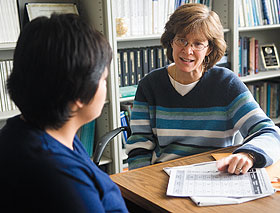  |
| HOME | THIS ISSUE | CALENDAR | GRANTS | BACK ISSUES | < BACK | NEXT > |
Environmental economist’s research area becoming a hot topicby Cindy Weiss - February 4, 2008 |
||||
| Economics professor Kathleen Segerson has worked as an environmental economist for 25 years. Now, public interest in her area of research is heating up, thanks to global warming. Cap and trade policies, fuel efficiency standards for automobiles, and how to value ecosystems are just some of the hot topics that environmental economists analyze. Unlike 25 years ago, when a spike in the cost of gas could still shock the public, the current interest in environmental economics is stimulated more by concern for the future, she has found. “Most of the impetus of energy policy today, I think, stems from climate change,” she says. “People are concerned about what we are doing to the planet.” Her own introduction to environmental policy began as a math major at Dartmouth. She took a course from Dennis Meadows, an engineering professor who co-authored a controversial 1972 study, Limits to Growth, about the consequences of a growing population and finite resources. Meadows helped her get a job in Washington, D.C., with Rep. John Dingell, D-Michigan, who then chaired a subcommittee on energy and power (Dingell now chairs the Committee on Energy and Commerce). Segerson participated in drafting the National Energy Act, and that inspired her to go to graduate school at Cornell University in environmental economics. “I wanted to do something socially relevant,” she recalls. At Cornell she took her first economics course ever. It was an interest that would last. This January, Segerson was elected one of six national fellows of the Association of Environmental and Resource Economists. She was cited for the Segerson mechanism, a policy she developed for rewarding or penalizing farmers as a group for their agricultural pollution runoff. She also is vice chair of an Environmental Protection Agency Science Advisory Board committee that is about to deliver a report on how to value the protection of ecological services and systems. Over the years, she has seen the public’s interest in environmental economics go bullish, bearish, and bullish again. In 1973, the Arab oil embargo was a big shock for Americans, as gasoline supplies shortened, lines at gas stations lengthened, and prices soared. Then people got used to higher prices, and they adjusted without making fundamental changes, she notes: “We stayed reliant on fossil fuels, just at a higher price.” As interest in energy savings grows again, a question remains as to whether people will change their behavior fundamentally, she says. One of her special interests is incentives for voluntary control of pollution. “They will work if there is a sufficiently strong incentive to participate,” she says. She also has focused on the interface between law and the economy, such as balancing society’s interests and needs with the costs of implementing Superfund legislation.
Her earliest research was on controlling agricultural pollution, which has diffuse sources and often is difficult to monitor Trade-offs and balancing economic and environmental benefits are at the heart of her work. Corporate Average Fuel Economy standards, for instance, are designed to increase the production of fuel-efficient cars. To get greater fuel efficiency, however, customers have to choose smaller, lighter cars. But in other consumer products, such as washing machines and refrigerators, the more energy efficient model may be more desirable, she says, because it often does a better job as well as having a lower long-term energy cost. Cap and trade policies, in which a cap is set on emissions but big emitters may offset their excesses by buying credits from those who use less energy, were first proposed by economic theorists in the 1970s, Segerson notes. “This whole interest in cap and trade has brought more attention to the role that economists can play in designing policy for environmental protection,” she says. As a science advisory board member for the EPA, she is vice chair of a committee that is writing a major report to be delivered this spring on how to value the impact of EPA rules on ecosystems. It will reflect the contributions of economists, decision scientists, ecologists, philosophers, psychologists, engineers, and a lawyer. Decision science is an interdisciplinary field that includes economists, IT specialists, statisticians, and others, to facilitate decision-making. At UConn, Segerson is an affiliate of the Center for Environmental Sciences and Engineering (CESE). She has a joint appointment in the College of Liberal Arts and Sciences (CLAS) and the College of Agriculture and Natural Resources. She chairs the popular Edwin Way Teale Lecture Series on the environment, and has been a recipient of the UConn Alumni Association award for faculty excellence in graduate teaching. Three times she was designated “Most Appreciated Faculty” by graduate students in the economics department, where she formerly was head. She also received the AAUP service award in 2007. Next year she will take over as president of the Association of Environmental and Resource Economists. The field has grown alongside the environmental movement, Segerson notes, and has the potential for enormous future growth, as countries such as China face the issue of balancing economic needs and desires with environmental concerns.
|
| ADVANCE HOME UCONN HOME |

